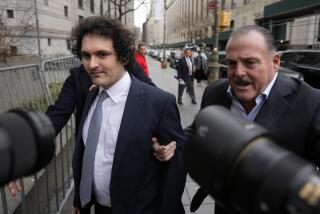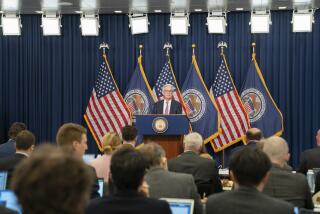‘Flash crash’ panel calls for market overhaul
- Share via
U.S. regulators should stem the growing tide of anonymous stock trading and consider charging high-frequency traders for their disproportionate amount of buy and sell orders, said a panel of experts advising how to avoid another “flash crash.”
The panel’s 14 recommendations for U.S. securities and futures regulators contained some bold ideas that, taken together, would overhaul the high-speed electronic trading market.
The panel told regulators Friday that today’s markets can easily breed uncertainty among investors. It asked them to move urgently on its suggestions.
“The recommendations are a good first step … but from a practical standpoint of avoiding another [crash] in the future, it doesn’t go far enough. I don’t think it’s possible to prevent another one from happening,” said Adam Sarhan, chief executive of Sarhan Capital in New York.
U.S. regulators were cautious about some of the boldest recommendations, including new fee structures to encourage liquidity and discourage high numbers of order cancellations.
“I do not know where we as a commission would come down on fees,” Securities and Exchange Commission chief Mary Schapiro said after the panel meeting on its recommendations.
The unprecedented market crash on May 6, 2010, sent the Dow Jones industrial average down some 700 points before rebounding, all in a matter of minutes. It rattled investors, exposed flaws in the structure of markets and set regulators on a mission to fix the system and restore confidence.
The eight-member panel suggested the SEC consider forcing the banks, hedge funds and others that facilitate stock trading away from the public exchanges to give investors a better price by a minimum amount.
It also urged regulators to consider a way to better allocate the “costs imposed by high levels of order cancellations, including perhaps requiring a uniform fee across all exchange markets.”
Last summer, regulators and others began raising questions about the huge amount of message traffic, or “noise,” in the markets and whether it allowed some high-speed, short-term traders to manipulate prices for profit gains.
“What market regulation now has to do is limit uncertainty,” said Maureen O’Hara, a professor of finance at Cornell University and member of the flash crash panel. “You limit uncertainty by limiting the amount of movement a price can have before it falls off the map.”
The changes would require the SEC and Commodity Futures Trading Commission to take on a massive amount of research and rulewriting at a time when the agencies are straining to carry out the Dodd-Frank financial reform law.
While some have argued that the crash was a freak event that called for obvious adjustments, such as the new “circuit breaker” trading halts, others said it was a wake-up call to finally get a firm handle on what could destabilize capital markets.
The panel also advised regulators to consider a “trade at” order routing rule — something that would hurt the growing ranks of “dark pools” where trading is done anonymously.
Some 33% of U.S. stock trading takes place away from exchanges, up from 20% four years ago. Some of the biggest internalizers are market maker Knight Capital Group Inc., bank Goldman Sachs Group Inc. and hedge fund Citadel.
A “trade at” rule would generally prohibit any of the dozens of U.S. venues and wholesale market makers from executing an incoming order unless they were already publicly displaying the best bid or offer in that particular stock. Schapiro expressed support for such a rule Friday.
More to Read
Inside the business of entertainment
The Wide Shot brings you news, analysis and insights on everything from streaming wars to production — and what it all means for the future.
You may occasionally receive promotional content from the Los Angeles Times.










